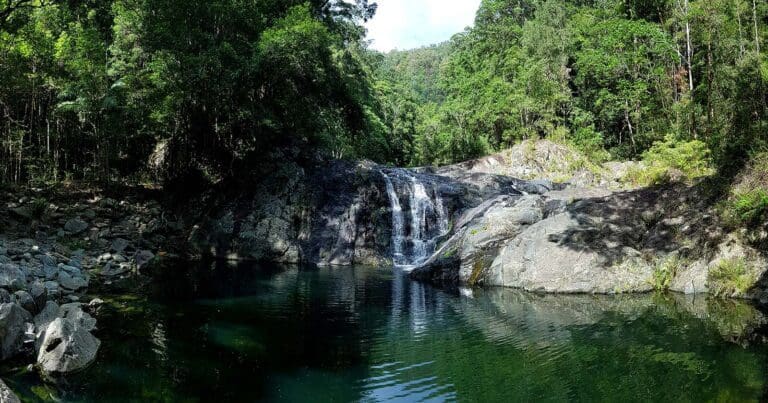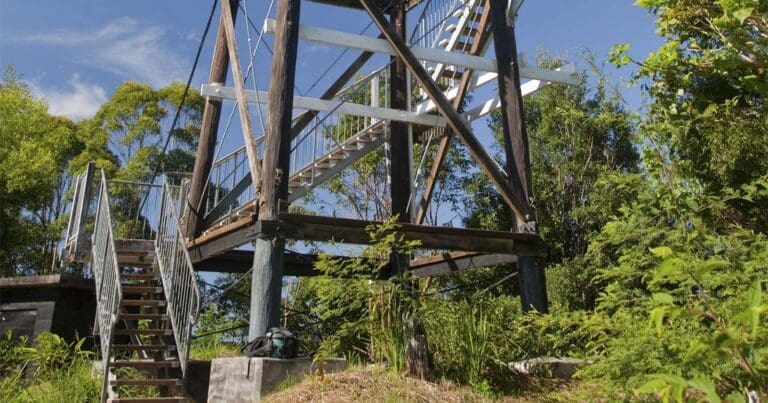Trail Fast Facts
Mount Allan Trail is a 10km, grade 4 hike in Conondale National Park, Queensland. This hike typically takes 3.5 hours to complete.
Hike Overview
Magnificent forests, deep gorges, quiet campsites and cool mountain streams - you'll find all of these things inside Conondale National Park. To explore the park by foot, head to the popular Booloumba Creek day-use area and set off on the Mount Allan Trail which stretches 10 kilometres through bushland. This trail is considered a difficult grade and will take about 3.5 hours to complete.
Track Grade
Grade 4 (Hard) - Challenging Walks for Experienced Walkers: Grade 4 on the AWTGS signifies challenging walking tracks. Bushwalking experience is recommended for these tracks, which may be long, rough, and very steep. Directional signage may be limited, requiring a good sense of navigation. These walks are suited for experienced walkers who are comfortable with steeper inclines, rougher terrain, and potentially longer distances.
Map and GPX file
Max elevation: 584 m
Min elevation: 156 m
Total climbing: 743 m
Total descent: -743 m
Trailhead
Sorry, no records were found. Please adjust your search criteria and try again.
Sorry, unable to load the Maps API.
Getting there
The Conondale National Park is located 15km south of Kenilworth township, and about one hour west of Maroochydore on the Sunshine Coast. 130km north of Brisbane.
From Brisbane, follow the Bruce Highway north, and take the Kenilworth exit. Follow the signs for Kenilworth, travelling along the Eumundi-Kenilworth Road for about 28km. Go through Kenilworth and continue toward Maleny. The turn-off to Sunday Creek Road is about 7km past Kenilworth and the turn-off to Booloumba Creek day-use and camping areas is a further 500m.
Alternative access is via Maleny. Go through Maleny and follow the signs to Kenilworth. On the way to Kenilworth, pass through a small town called Conondale. The turn-off to Booloumba Creek day-use and camping areas is about 13km past Conondale and the turn-off to Sunday Creek Road is a further 500m.
All park roads are gravel and at present are only suitable for high-clearance four-wheel drive vehicles. Booloumba Creek area roads include several natural creek crossings. Heavy rain can flood creek crossings. If it's flooded, forget it! Wait it out. Visit the QLD parks and forests website for current Park alerts and closures.
Photo gallery
If you’ve got some great shots from this hike, I’d love to see them! Please upload your .jpg files here to help inspire other hikers and show off the beauty of the trail.
A quick note: Uploading your photos doesn’t mean you lose ownership. You’ll be credited for any photos you share, and you can request to have them removed at any time.
About the region
Conondale National Park is 130 km north of Brisbane in the Sunshine Coast Hinterland near the town of Conondale in the south east Queensland bioregion. The park covers an area of 35,648 hectares protecting large areas of subtropical rainforest, woodlands, wet and dry sclerophyll forest including Queensland's tallest tree. The park contains areas of regenerating forest which have been previously logged; areas of forest plantations also border the park. The park is currently managed by the Department of National Parks, Recreation, Sports and Racing (NPRSR) under the Nature Conservation Act 1992.
Since the 1860s the Conondale region has been impacted by land clearing for agriculture, mining and logging, today the park is a refuge for many species now rare and threatened. Threatened species such as the plumed frogmouth, giant barred frog, Conondale crayfish, spotted-tailed quoll, Gympie nut and richmond birdwing butterfly have been recorded in the park and are currently targeted for conservation management to mitigate threats to their survival. Species of interest include the southern gastric brooding frog which mysteriously disappeared in 1981 and is presumed extinct.
The landscape has a rugged topography with gorges, valleys and a number of mountains above 700m with the highest peak being Mount Langley at 868m. Throughout the park there are scenic waterfalls such as Booloumba Creek Falls, cascades and numerous boulder strewn creeks. The Conondale range forms a catchment divide between the Brisbane River and Mary River with the southernmost tributaries of the Mary river forming in Booloumba and Yabba creek.[6] The park also contains wetlands of national significance. These tributaries are important for the threatened Mary river cod which has declined in these creeks.
Gold mining at Kilcoy Creek, 1933
The region has a sub-tropical climate with a mean annual rainfall of 1,500 mm, the majority of rainfall occurs seasonally in summer (DecemberMarch) usually with heavy downpours and winters generally cold and dry with occasional frosts. Major vegetation types include a mix of complex notophyll vine forest, sub-tropical rainforest, woodlands, bangalow palm forests, wet sclerophyll and dry sclerophyll forest with rainforest occurring mainly at higher altitudes and along watercourses.
For more information on this hiking trail, please visit Queensland.com
Suggest an edit
Spotted a change on this trail? Maybe there are new features, the route has shifted, or the trail is permanently closed. Whatever the update, I’d love your input. Your feedback helps fellow hikers stay informed and ensures that our trail info stays fresh and reliable.
Similar trails nearby
Looking for things to do in Conondale National Park or nearby? Try these similar hikes or bushwalks.
Let someone know
Adventure with Confidence: Register Your Trip Plans
Before you hit the trail, take a moment to fill out our trip intentions form. It’s a simple way to share important details about your hike with family or friends. If things don’t go as planned and you’re not back on time, they can easily notify emergency services, helping to ensure a quick response and reducing worry. Enjoy your outdoor adventure knowing that you’ve taken a smart step for your safety.
Gear to consider
What you carry in your pack will depend on the weather, terrain, time of year, type of adventure, and personal preferences. Having trouble deciding what gear’s right for you? My free planning, food and packing checklists provide an introduction to things your could consider (as well as the Ten Essentials) on your day, overnight and multi-day adventures. Customise your kit according to your personal needs, always considering safety first.
Explore Safe
While planning your hike, it’s important to check official government sources for updated information, temporary closures and trail access requirements. Before hitting the trail, check local weather and bushfire advice for planned burns and bushfire warnings and let someone know before you go. Plan ahead and hike safely.
Weather
Acknowledgement of Country
Trail Hiking Australia acknowledges the Traditional Owners of the lands on which we hike and pay respects to their Elders, past and present, and we acknowledge the First Nations people of other communities who may be here today.






